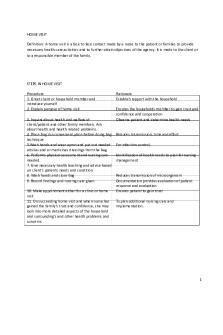Cubing prewrite technique PDF

| Title | Cubing prewrite technique |
|---|---|
| Author | Tora Nishobe |
| Course | English Composition I |
| Institution | Northwest Florida State College |
| Pages | 1 |
| File Size | 28.1 KB |
| File Type | |
| Total Downloads | 100 |
| Total Views | 190 |
Summary
Lecture handout for Dr. Jon Brooks...
Description
PREWRITING EXERCISE: CUBING (Taken from E.C. Neeld's Writing) Cubing is a technique for swiftly considering a subject from six points of view. The emphasis is on swiftly and on six. Often writers cannot get going on a subject because they are locked in on a single way of looking at the topic, and that is where cubing works well. Cubing lets you have a single point of view for only three to five minutes, then moves you to the next point of view. When you have finished cubing, you have spent 18 to 30 minutes deliberately varying your point of view. This technique moves very swiftly and is quite structured. RULES FOR CUBING Use all six sides of the cube. Imagine a cube--think of it as a solid block. Now imagine that each side has something different written on it. One side says: Describe it. Another says: Compare it. A third says: Associate it. A fourth says: Analyze it. A fifth says: Apply it. The sixth says: Argue for or against it.
For the cubing technique to succeed, you need to use all six sides. It is a technique to help you learn to look at a subject from a variety of perspectives. Move fast. Do not allow yourself more than three to five minutes on each side. The energy in this creating technique comes from shifting your perspective on the subject often. By moving around the cube, one side after the other, in rapid succession, you see that you can look at your subject from different angles and that you can talk about it in different ways. You are taking a quick run into your mind for whatever presents itself on that angle, and the quickness of the run is important. It is this switch that makes cubing work.
APPLICATION: Do each of the six steps in order, spending three to five minutes on each side. DESCRIBE IT: Look at the subject closely and describe what you see. Colors, shapes, sizes, and so forth. COMPARE IT: What is it similar to? What is it different from? ASSOCIATE IT: What does it make you think of? What comes into your mind? It can be similar things, or you can think of different things, different times, places, and people. Let your mind go and see what associations you have for this subject. ANALYZE IT: Tell how it is made. (At this point, you do not have to know; you can use your imagination.) APPLY IT: Tell what you can do with it, how it can be used. ARGUE FOR OR AGAINST IT: Go ahead and take a stand. Use any kind of reasons you want to-rational, silly, or anywhere in between. Then switch to the other side of the issue and argue that....
Similar Free PDFs

Cubing prewrite technique
- 1 Pages

Guide technique
- 80 Pages

Technique Analysis
- 7 Pages

Laban Technique
- 3 Pages

aseptic technique
- 8 Pages

Caracteristique technique
- 1 Pages

OSCE inhaler technique
- 4 Pages

LA Technique Psychanalytique
- 37 Pages

Guide to ILAC Technique
- 10 Pages

BAG- Technique - RLE Bag
- 7 Pages

Fiche technique - populisme
- 7 Pages

Cross-match technique
- 4 Pages

Legal Technique and Logic
- 3 Pages

Technique de Coloration
- 15 Pages
Popular Institutions
- Tinajero National High School - Annex
- Politeknik Caltex Riau
- Yokohama City University
- SGT University
- University of Al-Qadisiyah
- Divine Word College of Vigan
- Techniek College Rotterdam
- Universidade de Santiago
- Universiti Teknologi MARA Cawangan Johor Kampus Pasir Gudang
- Poltekkes Kemenkes Yogyakarta
- Baguio City National High School
- Colegio san marcos
- preparatoria uno
- Centro de Bachillerato Tecnológico Industrial y de Servicios No. 107
- Dalian Maritime University
- Quang Trung Secondary School
- Colegio Tecnológico en Informática
- Corporación Regional de Educación Superior
- Grupo CEDVA
- Dar Al Uloom University
- Centro de Estudios Preuniversitarios de la Universidad Nacional de Ingeniería
- 上智大学
- Aakash International School, Nuna Majara
- San Felipe Neri Catholic School
- Kang Chiao International School - New Taipei City
- Misamis Occidental National High School
- Institución Educativa Escuela Normal Juan Ladrilleros
- Kolehiyo ng Pantukan
- Batanes State College
- Instituto Continental
- Sekolah Menengah Kejuruan Kesehatan Kaltara (Tarakan)
- Colegio de La Inmaculada Concepcion - Cebu

